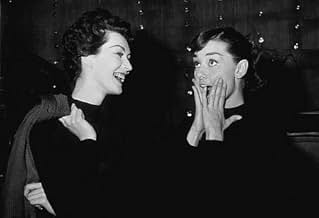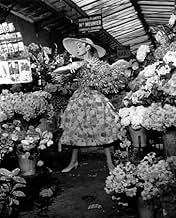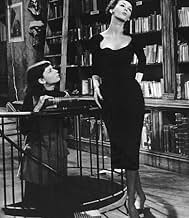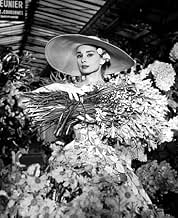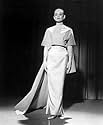CALIFICACIÓN DE IMDb
7.0/10
35 k
TU CALIFICACIÓN
Un prestigioso fotógrafo de moda parisino busca a la mujer perfecta para su próximo artículo.Un prestigioso fotógrafo de moda parisino busca a la mujer perfecta para su próximo artículo.Un prestigioso fotógrafo de moda parisino busca a la mujer perfecta para su próximo artículo.
- Dirección
- Guionista
- Elenco
- Nominado a 4 premios Óscar
- 2 premios ganados y 10 nominaciones en total
Heather Ames
- Junior Editor
- (sin créditos)
Fern Barry
- Southern Wife
- (sin créditos)
Brandon Beach
- Fashion Show Guest
- (sin créditos)
Paul Bisciglia
- Photographer
- (sin créditos)
- Dirección
- Guionista
- Todo el elenco y el equipo
- Producción, taquilla y más en IMDbPro
Opiniones destacadas
Outstanding. Beautiful. Classic. What a real lady!!!
The photo sequence in Paris has never been topped. Such a 10+ movie, I can just watch it over and over. Those are kind of strange adjectives and comments from me, especially since I'm a Sci-Fi, action, fantasy kind of movie fan.
This makes me wonder, will we ever have another Audrey?? Maybe an actress who is even close? To think that she thought she had: 1. A square face, 2. A big nose and 3. Big feet. That just shows how human and natural she really was..........
What a surprise for me to find this movie. I had never even heard of it untill it came out on DVD. S'Marvelous!!
The photo sequence in Paris has never been topped. Such a 10+ movie, I can just watch it over and over. Those are kind of strange adjectives and comments from me, especially since I'm a Sci-Fi, action, fantasy kind of movie fan.
This makes me wonder, will we ever have another Audrey?? Maybe an actress who is even close? To think that she thought she had: 1. A square face, 2. A big nose and 3. Big feet. That just shows how human and natural she really was..........
What a surprise for me to find this movie. I had never even heard of it untill it came out on DVD. S'Marvelous!!
You have Audrey Hepburn, you have Fred Astaire, you have Gershwin songs. Who needs a plot?
Okay, there was something of a plot, something about a Greenwich Village girl who wants to go to Paris, talk b.s. philosophy on the Left Bank, wear black clothes and no make-up. It reads like something out of one of Woody Allen's early stories - before he wrote it!
Audrey Hepburn never knew how to look bad nor act bad. But in this she looks light-years more beautiful as the proverbial Greenwich Village used-book-store Plain Jane than any Paris fashion model - then or now.
Okay, there was something of a plot, something about a Greenwich Village girl who wants to go to Paris, talk b.s. philosophy on the Left Bank, wear black clothes and no make-up. It reads like something out of one of Woody Allen's early stories - before he wrote it!
Audrey Hepburn never knew how to look bad nor act bad. But in this she looks light-years more beautiful as the proverbial Greenwich Village used-book-store Plain Jane than any Paris fashion model - then or now.
As long as you do not take the premise or the characters or the plot too seriously, this is an enjoyable movie with an interesting pairing of Fred Astaire and Audrey Hepburn, plus an excellent supporting performance by Kay Thompson and some good-looking settings and scenery. The musical numbers are pleasant, if rather on the light side. Stanley Donen has the right touch in keeping things together without making the seams show too often.
Hepburn is cast in a somewhat unexpected role, as a drab intellectual store clerk who gets involved with Fred Astaire's (much older) photographer character. Audrey is so charming that's it's very difficult to think of her as a wallflower, and while Astaire is as energetic as ever, there are more than a couple of occasions on which the relationship doesn't really look believable, despite the best efforts of the two stars. The plot isn't supposed to be anything weighty anyway, so perhaps that's the price you have to pay for a rather different pairing.
Kay Thompson provides many of the best moments. Sometimes the satire of trendy philosophy comes off well, at other times it gets a little dull. Not to be forgotten are the colorful and interesting settings and backgrounds, which set off the story and music fairly well. It's sometimes a strange combination, but as lighter entertainment it all works well enough.
Hepburn is cast in a somewhat unexpected role, as a drab intellectual store clerk who gets involved with Fred Astaire's (much older) photographer character. Audrey is so charming that's it's very difficult to think of her as a wallflower, and while Astaire is as energetic as ever, there are more than a couple of occasions on which the relationship doesn't really look believable, despite the best efforts of the two stars. The plot isn't supposed to be anything weighty anyway, so perhaps that's the price you have to pay for a rather different pairing.
Kay Thompson provides many of the best moments. Sometimes the satire of trendy philosophy comes off well, at other times it gets a little dull. Not to be forgotten are the colorful and interesting settings and backgrounds, which set off the story and music fairly well. It's sometimes a strange combination, but as lighter entertainment it all works well enough.
The first of two films released in 1957 in which Fred Astaire effectively bade farewell to the genre he had bestrode like a colossus for nearly a quarter of a century is the cinematic equivalent of gorging yourself on a box of chocolates without the calories.
The title photographs by Richard Avedon (on whom the character played by Astaire was based) establish the iconic fifties cool that never lets up for the rest of the film. Had they shot the whole thing in the studio, the Gershwin score, Technicolor, VistaVision and Edith Head creations worn by all the cast but Audrey Hepburn would already have induced pleasure overload. But producer Roger Edens also shipped the crew to Paris and whipped that into the brew.
It shows how spoiled they were in those days that it didn't collect a single Oscar.
The title photographs by Richard Avedon (on whom the character played by Astaire was based) establish the iconic fifties cool that never lets up for the rest of the film. Had they shot the whole thing in the studio, the Gershwin score, Technicolor, VistaVision and Edith Head creations worn by all the cast but Audrey Hepburn would already have induced pleasure overload. But producer Roger Edens also shipped the crew to Paris and whipped that into the brew.
It shows how spoiled they were in those days that it didn't collect a single Oscar.
This 1957 musical is a little odd. It has a title based on an original 1920s Gershwin musical (that included the title song) which starred Fred and Adele Astaire. It was a musical and scenic valentine to France (but only one tune in it deals with France - "Bonjour Paris!". It is a spoof on the modern fashion magazines, fashions in general, and advertising - but the spoof while sharp at times is never pushed. The opening sequence, "Think Pink," describes how Kay Thompson plans a campaign to make the American woman go for "pink" clothes, accessories, toothpaste, etc., only to admit to her assistant she personally loathes the color. It takes full advantage of the attractive face and features of Hepburn, who is convinced to be a model and help push a new line of fashions in Paris. And it makes two characters into imitations of Richard Avedon the photographer (Astaire as Dick Avory) and Jean-Paul Sartre (Michel Auclair as Prof. Emile Flostre).
Avedon was a rarity - a fashion photographer who became a great artistic portrait photographer. Astaire never is shown taking pictures of great or famous people in the film but several times he demonstrates a refinement that separates him from the rest of Kay Thompson's entourage (most of whom don't care what havoc they cause, as long as they get their jobs done). He also has enough sense to question Hepburn's accepting of "empathicalism", and it's viability. Witness his moment in the bistro pouring wine to the two old codgers who are quite pleasant to him while he insults them in English. Hepburn, of course, is so insistent on the validity of her philosophical beliefs that she rejects Astaire's warnings, and jeopardizes the fashion show.
The final blow (seemingly) to the Astaire - Hepburn relationship is when he confronts Flostre at the author's home. He knocks out the Professor, and his brutality demolishes the relationship with Hepburn. But within minutes Hepburn sees another side to Flostre which is unexpected, and suddenly realizes that Astaire may be right after all.
The character of Flostre is obviously based on that of Jean-Paul Sartre, the founder of "existentialism". Based on in some details, but not in theory. "Empathicalism" has to do with trying to empathize with others so as to have a proper response to their needs and aspirations. "Existentialism" has to do with: "An introspective humanism or theory of man which expresses the individual's intense awareness of his contingency and freedom; a theory which states that the existence of the individual precedes his essence." This is from Webster's New Collegiate Dictionary. Sartre has a more complex view of man and society, and one can plow through BEING AND NOTHINGNESS to try to understand it. In fact some critics have wondered if the Nobel Prize Winner eventually got very wrong headed about his theory. But he certainly seems a meatier philosopher than his celluloid copy.
But Flostre does have the trappings of Sartre on him. He is revered by his followers world wide (such as Hepburn). He is a man with sexual appetite (as Sartre was with his long time companion and fellow writer Simone Beauvoir). And there is some traces of an anti-capitalist, even anti-American attitude in him. It is not definitely pushed, but when Astaire and Thompson break into his house during a party, they pretend they are American share cropper singers whom Flostre had brought to France to perform for his guests. Now, we never hear what this actual pair actually would sing, but judging from their background they would have to throw in some protest songs. Sartre was very critical of the U.S.A. and capitalism (today his fans have to explain Sartre's willingness to accept Russian imperialist moves under Communism in the 1940s, 1950s, and 1960s - they find it very hard to do so).
On the whole the parts of the film work well, so I give it seven stars. Kay Thompson is best recalled for being the creator of the little girl at the Plaza "Eloise", but she shows here a highly entertaining performance as Maggie Prescott, the editor who pushes and loathes pink. The film would have been better if somehow Avedon's portrait photography had been brought into the story, possibly in a final scene with Flostre as his subject. However, even without such a sequence the film is rewarding to watch, especially in the musical numbers. Astaire does equally well with Thompson and with Hepburn as his partners here.
Avedon was a rarity - a fashion photographer who became a great artistic portrait photographer. Astaire never is shown taking pictures of great or famous people in the film but several times he demonstrates a refinement that separates him from the rest of Kay Thompson's entourage (most of whom don't care what havoc they cause, as long as they get their jobs done). He also has enough sense to question Hepburn's accepting of "empathicalism", and it's viability. Witness his moment in the bistro pouring wine to the two old codgers who are quite pleasant to him while he insults them in English. Hepburn, of course, is so insistent on the validity of her philosophical beliefs that she rejects Astaire's warnings, and jeopardizes the fashion show.
The final blow (seemingly) to the Astaire - Hepburn relationship is when he confronts Flostre at the author's home. He knocks out the Professor, and his brutality demolishes the relationship with Hepburn. But within minutes Hepburn sees another side to Flostre which is unexpected, and suddenly realizes that Astaire may be right after all.
The character of Flostre is obviously based on that of Jean-Paul Sartre, the founder of "existentialism". Based on in some details, but not in theory. "Empathicalism" has to do with trying to empathize with others so as to have a proper response to their needs and aspirations. "Existentialism" has to do with: "An introspective humanism or theory of man which expresses the individual's intense awareness of his contingency and freedom; a theory which states that the existence of the individual precedes his essence." This is from Webster's New Collegiate Dictionary. Sartre has a more complex view of man and society, and one can plow through BEING AND NOTHINGNESS to try to understand it. In fact some critics have wondered if the Nobel Prize Winner eventually got very wrong headed about his theory. But he certainly seems a meatier philosopher than his celluloid copy.
But Flostre does have the trappings of Sartre on him. He is revered by his followers world wide (such as Hepburn). He is a man with sexual appetite (as Sartre was with his long time companion and fellow writer Simone Beauvoir). And there is some traces of an anti-capitalist, even anti-American attitude in him. It is not definitely pushed, but when Astaire and Thompson break into his house during a party, they pretend they are American share cropper singers whom Flostre had brought to France to perform for his guests. Now, we never hear what this actual pair actually would sing, but judging from their background they would have to throw in some protest songs. Sartre was very critical of the U.S.A. and capitalism (today his fans have to explain Sartre's willingness to accept Russian imperialist moves under Communism in the 1940s, 1950s, and 1960s - they find it very hard to do so).
On the whole the parts of the film work well, so I give it seven stars. Kay Thompson is best recalled for being the creator of the little girl at the Plaza "Eloise", but she shows here a highly entertaining performance as Maggie Prescott, the editor who pushes and loathes pink. The film would have been better if somehow Avedon's portrait photography had been brought into the story, possibly in a final scene with Flostre as his subject. However, even without such a sequence the film is rewarding to watch, especially in the musical numbers. Astaire does equally well with Thompson and with Hepburn as his partners here.
¿Sabías que…?
- TriviaFred Astaire's character is based on photographer Richard Avedon and his wife, Doe, who, like the character "Jo Stockton," became a noted model despite her indifference toward that profession. In fact, it is Avedon who set up most of the photography for this film, including the famous face portrait of Audrey Hepburn unveiled during the darkroom sequence.
- ErroresAfter Dick kisses Jo and leaves the bookstore, Jo begins to sing "How Long Has This Been Going On". As she sings to herself while looking at the mirror in the supposedly empty bookstore, someone is reflected in the mirror moving around on the second floor of the bookstore.
- Citas
Dick Avery: When I get through with you, you'll look like... What do you call beautiful? A tree. You'll look like a tree.
- Créditos curiososThe opening credits, designed by film consultant Richard Avedon, consist of traditional film credit display interspersed with live action, fashion models and photographic film.
- ConexionesEdited into Chop Suey (2001)
- Bandas sonorasOverture: Funny Face/'S Wonderful/Think Pink!
(uncredited)
Lyrics by Ira Gershwin
Music by George Gershwin
Performed by Fred Astaire
Selecciones populares
Inicia sesión para calificar y agrega a la lista de videos para obtener recomendaciones personalizadas
- How long is Funny Face?Con tecnología de Alexa
- Is "Funny Face" based on a book?
- Was "Funny Face" actually filmed in Paris?
Detalles
- Fecha de lanzamiento
- País de origen
- Idiomas
- También se conoce como
- Funny Face
- Locaciones de filmación
- Château de la reine blanche, Coye-la-Forêt, Oise, Francia(wedding dress photo shoot, Dick's marriage proposal)
- Productora
- Ver más créditos de la compañía en IMDbPro
Taquilla
- Presupuesto
- USD 3,000,000 (estimado)
- Total a nivel mundial
- USD 1,669
- Tiempo de ejecución1 hora 43 minutos
- Color
- Relación de aspecto
- 1.85 : 1
Contribuir a esta página
Sugiere una edición o agrega el contenido que falta

Principales brechas de datos
By what name was La cenicienta de París (1957) officially released in India in English?
Responda






